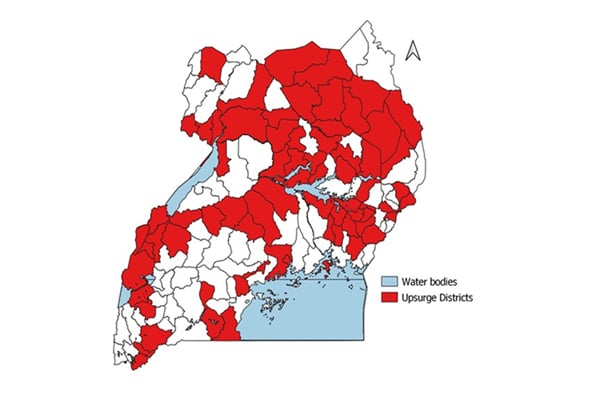Prime
Govt confirms malaria upsurge in 70 districts

Map showing the most affected districts. Source: Ministry of Health
What you need to know:
- The most affected districts are Budaka, Kween, Nabilatuk, Bugiri, Amolatar, Ntoroko, Namutumba, Alebtong, Amuru, Otuke, Kole, Pader, Omoro, Oyam, Kagadi, Zombo, Nwoya, Dokolo, Maracha, Butebo, Gulu, Agago, Kakumiro, Lira, Manafwa, Nebbi and Rakai.
- The malaria test positivity rate has increased from an average of 30 percent early this year to about 58 percent.
The Ministry of Health has announced a worrying resurgence in malaria infections in 71 districts across the country, signalling an increase in financial losses to families through treatment and heightened death risk.
Statistics from the ministry indicate that the malaria test positivity rate increased from an average of 30 percent early this year to the current estimate of 58 percent.
Districts such as Alebtong, Amuru and Otuke in northern Uganda have a positivity rate above 80 percent. The positivity rate refers to the positive cases detected from analysed blood samples from people.
Dr Jane Ruth Aceng, the Health minister, made the revelation about the resurgence yesterday while receiving a donation of malaria test kits worth Shs4b from the kingdom of Busoga.
“Right now in the country, 71 districts in the country are experiencing an upsurge with affected areas, including Busoga, Lango, West Nile, Acholi and Karamoja,” she said.
Dr Diana Atwiine, the permanent secretary of the ministry, blamed the resurgence on heavy rainfall, which triggered flooding in many places in the country. Floods provide a good breeding ground for mosquitoes.
“We have had challenges with climate change. We had brought down the problem of malaria significantly and we thought by now we should have brought the burden further down. But the prevalence of 9 percent is still a huge one, it keeps on oscillating based on the season,” she said.
Statistics from the ministry also show that the prevalence of malaria reduced from 42 percent in 2011 to the current prevalence of 9 percent.
Dr Atwiine said there is a need to collectively amplify the message of malaria prevention to the communities.
Sleeping under treated mosquito nets, destroying stagnant water near homes, indoor residual spray and treatment of infected people are some of the ways to prevent malaria.
Dr Aceng warned that the government’s ambition of economic transformation through the Parish Development Model will not yield the expected results if malaria issues are not addressed.
“The government spends on average $160m (Shs596b) annually on malaria,” she said.
The Kyabazinga of Busoga, Mr William Wilberforce Kadhumbula Gabula Nadiope IV, said at the event that the prevalence of malaria in his area is currently estimated at 21 percent, which is higher than the national average of 9 percent.
“I have accepted the request by partners and the ministry to have my personal involvement as a champion in the renewed efforts to fight against malaria in the Stop Malaria campaign,” he said.
Dr Aceng also reiterated the plans to introduce malaria vaccines next year to increase the fight. The vaccine has an efficacy of around 50 percent in stopping malaria.
Dr Henry Mwebesa, the Director General of Health Services, said they are focusing on improving malaria care through testing people before treatment as opposed to previous practise by doctors that relied on symptoms like fever.
“The donation [of test kits] you [the kingdom] is making today is important in improving the diagnosis of malaria. By last year 80 percent of the cases were diagnosed before treatment,” he added.
The 100,000 test kits worth Shs4b that can diagnose 2.5m people was donated by the kingdom through the support from Josu Links Ltd and SD Biosensor.
Mr Joel Kakira, the Managing director of Josu Links Ltd, said they are planning to establish a manufacturing facility for all types of diagnostic kits in Uganda.
Most affected
The most affected districts are Budaka, Kween, Nabilatuk, Bugiri, Amolatar, Ntoroko, Namutumba, Alebtong, Amuru, Otuke, Kole, Pader, Omoro, Oyam, Kagadi, Zombo, Nwoya, Dokolo, Maracha, Butebo, Gulu, Agago, Kakumiro, Lira, Manafwa, Nebbi and Rakai.




